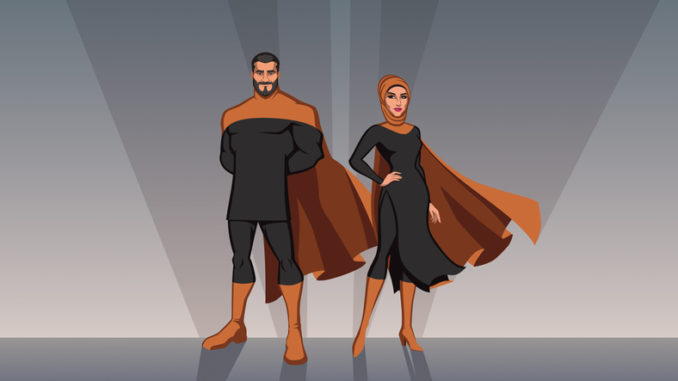
Can comic book characters help us conquer our fears and discover the hero within? Kat Nicholls explores
CREDIT: This is an edited version of an article that originally appeaerd on Happiful
When the first lockdown was announced in 2020 I made a decision to watch all the Marvel films, in chronological order, from Captain America to Endgame. Once I got through them, I moved on to the Lord of the Rings trilogy, the Harry Potter films, and the Buffy the Vampire Slayer box set.
I’ve always loved the fantasy/sci-fi genre and, looking back, it’s not surprising that, when confronted with something as unsettling as a global pandemic, I latched on to tales of triumph over adversity.
These stories can be inspiring, but they can also help us tap into something deeper when worked into therapy sessions. Dubbed ‘superhero therapy’ by some, counsellor Louise Brown explains that this approach involves using references from popular culture (not just superheroes) to help clients explore what they’re going through, and how they might make changes. “This can include using metaphors based on franchises that the client feels connected to, or asking what a character they admire might do in a similar situation to the one they’re experiencing,” Louise says.
Doing this can take away some of the emphasis from the client, shifting it into a fictional world. Louise notes that, when we do this, we go through a process of externalisation – which has several benefits. “Not only can it be easier to talk about the situation, and see it from different points of view, but because any action is not really the client’s action, new possibilities are able to emerge. For example, rather than talking about anxiety, we reference Harry Potter and discuss what their boggart would look like, and how the ‘riddikulus’ spell would work on it.
“Instead of talking about being worried about coming out to family members, and the burden of hiding parts of ourselves, we might discuss why Peter Parker has to wear a mask to be Spider Man, the potential difficulties of being ‘outed’, and dealing with the fallout.”
Louise notes that this approach can be helpful for those finding it hard to articulate what’s brought them to therapy. Starting a conversation about an interest can pave the way to discuss characters the client identifies with, or what they admire about them. Working with metaphors can also help people talk about difficult topics in an indirect way that feels more approachable. Louise adds that neurodivergent people may find it helpful to bring special interests into therapy. “Offering a space for the client to speak about their interest freely conveys a level of acceptance that can sometimes be lacking in other areas of their life. In therapy, not only is it OK to talk about it, but it becomes part of the work.
“Many neurodivergent clients have had negative experiences where they haven’t been accepted, and may even have been told they need to be more like everyone else. This can lead to masking, where they learn to hide who they are and act as if they are neurotypical – but this can have a hugely negative impact on wellbeing. Having a safe space to be themselves – where they can take the mask off – can be the first step towards self-acceptance and better mental health.”
Relating to the ‘origin story’
As well as looking at specific characters and their challenges, acknowledging the common threads between their stories can be helpful. Psychotherapist Sean Murphy explains how the ‘origin story’ is one many can relate to. “Most heroes carry pain from their past, yet these challenges have not created defects – quite the reverse. The resilience a superhero shows in overcoming life’s challenges becomes a fundamental part of their strength and moral compass.
“This is important when working with clients who have experienced difficult childhoods, and see themselves as deficient, or lacking, because of it. Many children unconsciously assume they must have done something wrong in order to explain their misfortune. Superhero mythology helps us understand that pain is a universally recognised feeling, but from that early grief can come great strength, meaning, and purpose.”
Sean also highlights the burden of responsibility most superheroes bear (who can forget the great line, “With great strength comes great responsibility” from Spider Man?) and how this dilemma mirrors one we all face. “The question for all of us is ‘What do I do with who I am?’” Sean says. “’What choices do I make, and what does that say about me? What do I take on as my responsibility, and what do I walk away from?’”
Acknowledging our choices, and sometimes recognising that we are mere mortals, can lead to breakthrough moments. Sean explains how this played out with a client who was struggling to keep her large family happy. “My client began to realise that, as an adult, she could not carry on being responsible for her siblings. It was making her ill. Her path to peace began by letting go of the responsibility she felt she had to uphold forever. Her admission ‘I am not Wonder Woman’ was an important step to realising where her choices and limitations were.”
Accepting our limitations can be important, but so can seeing our inner heroism, and this can be explored through our defining moments. Almost all heroes face great challenges and, when they continue defying the odds, their heroism is defined.
“Though we may not be fighting gods, demons and ghost armies, all of us face moments when life seems impossibly complicated, and we feel our vulnerability acutely,” Sean explains. Your challenges may look different from those in your favourite TV shows and movies, but heroes look different, too.
Don’t believe me? Look in the mirror, put your hands on your hips, and tell me what you see.

Be the first to comment